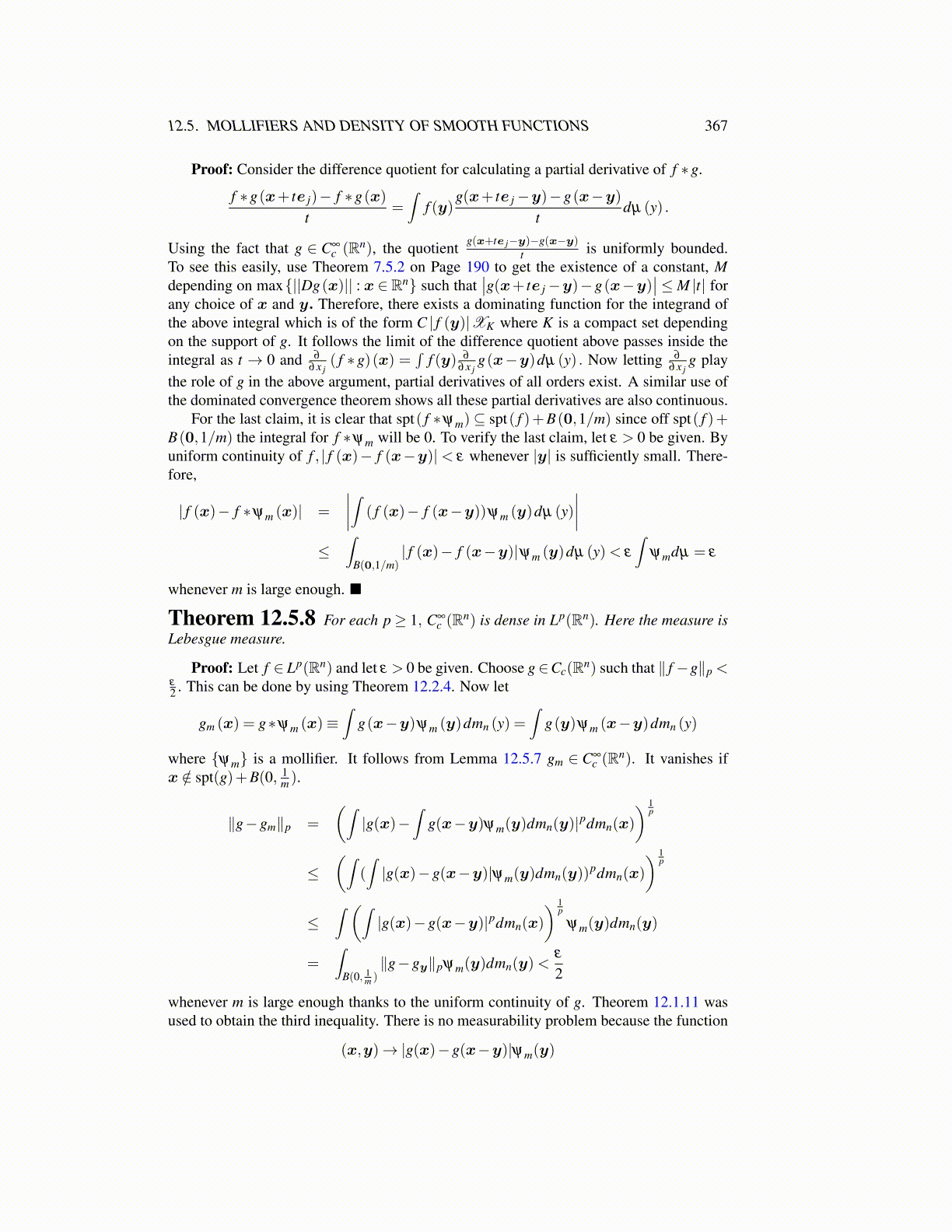
12.5. MOLLIFIERS AND DENSITY OF SMOOTH FUNCTIONS 367
Proof: Consider the difference quotient for calculating a partial derivative of f ∗g.
f ∗g(x+ te j)− f ∗g(x)t
=∫
f (y)g(x+ te j−y)−g(x−y)
tdµ (y) .
Using the fact that g ∈ C∞c (Rn), the quotient g(x+te j−y)−g(x−y)
t is uniformly bounded.To see this easily, use Theorem 7.5.2 on Page 190 to get the existence of a constant, Mdepending on max{||Dg(x)|| : x ∈ Rn} such that
∣∣g(x+ te j−y)−g(x−y)∣∣ ≤M |t| for
any choice of x and y. Therefore, there exists a dominating function for the integrand ofthe above integral which is of the form C | f (y)|XK where K is a compact set dependingon the support of g. It follows the limit of the difference quotient above passes inside theintegral as t → 0 and ∂
∂x j( f ∗g)(x) =
∫f (y) ∂
∂x jg(x−y)dµ (y) . Now letting ∂
∂x jg play
the role of g in the above argument, partial derivatives of all orders exist. A similar use ofthe dominated convergence theorem shows all these partial derivatives are also continuous.
For the last claim, it is clear that spt( f ∗ψm)⊆ spt( f )+B(0,1/m) since off spt( f )+B(0,1/m) the integral for f ∗ψm will be 0. To verify the last claim, let ε > 0 be given. Byuniform continuity of f , | f (x)− f (x−y)|< ε whenever |y| is sufficiently small. There-fore,
| f (x)− f ∗ψm (x)| =
∣∣∣∣∫ ( f (x)− f (x−y))ψm (y)dµ (y)∣∣∣∣
≤∫
B(0,1/m)| f (x)− f (x−y)|ψm (y)dµ (y)< ε
∫ψmdµ = ε
whenever m is large enough. ■
Theorem 12.5.8 For each p≥ 1, C∞c (Rn) is dense in Lp(Rn). Here the measure is
Lebesgue measure.
Proof: Let f ∈ Lp(Rn) and let ε > 0 be given. Choose g∈Cc(Rn) such that ∥ f −g∥p <ε
2 . This can be done by using Theorem 12.2.4. Now let
gm (x) = g∗ψm (x)≡∫
g(x−y)ψm (y)dmn (y) =∫
g(y)ψm (x−y)dmn (y)
where {ψm} is a mollifier. It follows from Lemma 12.5.7 gm ∈ C∞c (Rn). It vanishes if
x /∈ spt(g)+B(0, 1m ).
∥g−gm∥p =
(∫|g(x)−
∫g(x−y)ψm(y)dmn(y)|pdmn(x)
) 1p
≤(∫
(∫|g(x)−g(x−y)|ψm(y)dmn(y))
pdmn(x)
) 1p
≤∫ (∫
|g(x)−g(x−y)|pdmn(x)
) 1p
ψm(y)dmn(y)
=∫
B(0, 1m )∥g−gy∥pψm(y)dmn(y)<
ε
2
whenever m is large enough thanks to the uniform continuity of g. Theorem 12.1.11 wasused to obtain the third inequality. There is no measurability problem because the function
(x,y)→ |g(x)−g(x−y)|ψm(y)